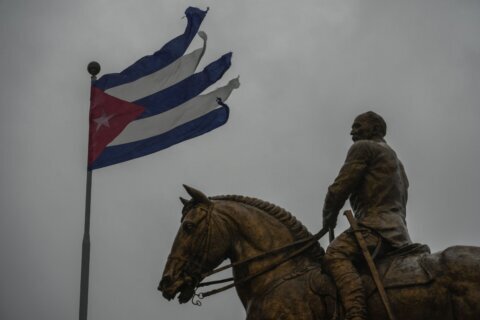While Iceland isn’t the only place in the world to view the northern lights, the Nordic country’s prime location near the Arctic Circle means the light show can be visible for more than 100 nights per year. And 2024 in particular will provide prime viewing opportunities.
“Interestingly, the sun is reaching its solar maximum (increased activity that’s conducive for northern lights) over the next few years, so 2024, 2025 and 2026 are prime years for getting a great light show,” explains Ryan Connolly, co-founder of Hidden Iceland.
While you’re never guaranteed to see the northern lights in Iceland, a little planning and forethought can pay off. Read on to discover the best time of year to visit, the most scenic places to go, unique tour options and more.
The best time to see the northern lights in Iceland
According to the country’s tourism authority, the best time to see the northern lights in Iceland is from September to mid-April, between 9 p.m. and 2 a.m. — and particularly around midnight.
Within that September to April period, there’s some debate about the optimal time to see the lights. Connolly cautions against a visit between late March and mid-April as well as in early September “so you don’t have to stay up too late to watch the sun set.” He and other experts recommend the following timeframes:
— November to January: You’re generally more likely to catch the northern lights during these darkest months. The sun barely rises around this time of the year, and the extremely long nights mean a longer window for the phenomenon to appear each day.
— Spring and fall equinoxes: Although midwinter probably offers the best chance of catching the aurora, some people recommend viewing it around the spring or fall equinoxes — that is, around March 20 and Sept. 23 (these dates change slightly each year). The science behind this timing is complex: In short, there tends to be more geomagnetic disturbance around the equinoxes, leading to stronger auroras. But don’t forget that the nights at these times are shorter than in midwinter, so your daily window for seeing the northern lights will also be shorter.
“We loved visiting in the fall for the opportunity to see the northern lights and for how few tourists there were,” says U.S. News Travel digital producer Leilani Osmundson, who visited Iceland last fall. “Sometimes it felt like we had the whole country to ourselves!”
— New moons: Moonlight can make it harder to spot the light show if the aurora is already faint — so serious aurora chasers may want to plan their visit to coincide with a new moon.
During the rest of the year, Iceland experiences near-constant daylight, meaning there isn’t enough darkness for the aurora borealis to appear. Put simply, if you visit in late spring or summer, you will not be able to see the lights, even if you go to the best viewing locations.
Northern lights forecast for Iceland
These are the most reliable resources for determining the likelihood of spotting the northern lights in the coming days:
— The Icelandic Meteorological Office: On the Icelandic Met Office’s website, forecasts show the Kp index, which measures disturbances in Earth’s magnetic field on a scale of zero to nine; the higher the number on the index, the stronger the aurora activity. The Met Office site also shows the cloud cover across Iceland, helping you determine whether you’ll actually be able to see the lights.
— Iceland’s Aurora Forecast: Iceland’s Aurora Forecast, which is run by locals with expert knowledge of the aurora, offers a similar forecast on a slightly more user-friendly site.
Unfortunately, longer-range predictions (for example, weeks or months in advance) are less reliable. There are 27-day forecasts available, but take note that solar activity can occur rapidly and may not factor into such predictions. However, due to the sun’s rotation cycle, if a strong aurora appears, it is considered more likely that the lights will appear again 27 days later, so this type of forecast may still be worth checking.
How to see the northern lights on your own
While it requires some extra planning, you can easily explore Iceland on your own. If you’re considering this route for your trip, take these expert travel tips into account:
— Avoid chasing the lights: “Once you are in an area with clear skies, you just need to wait, grab a cup of hot chocolate, and hope for the best,” Connolly says. “Driving around aimlessly rarely provides any benefits and isn’t much fun.”
— Manage your expectations: “The northern lights don’t necessarily always appear to the naked eye as we see them in photos,” Osmundson explains. “On our trip, they looked super green through the camera, but silvery and very faded to the naked eye.”
— Consider a self-drive tour: Several tour companies offer customized itineraries for travelers who want to explore on their own.
— Opt for four-wheel drive: Rent a vehicle with four-wheel drive for safety and peace of mind on wintry roads.
— Heed road restrictions and conditions: Regardless of when you visit, don’t go off the beaten track — off-roading is strictly illegal. You’ll also want to check road conditions via the Icelandic government’s official portal to avoid weather-related accidents.
— Consider travel insurance: An international travel insurance policy can provide car rental protections, medical care coverage and more.
The best places to see the northern lights in Iceland
The most basic rule for catching the northern lights is to go somewhere dark — and with Iceland’s sparse population, there’s no shortage of places that fit the bill. From fjords and glaciers to mountains and black sand beaches, these are some of the most notable places to see the northern lights in Iceland.
Jökulsárlón
This glacial lagoon is adorned with icebergs, which break off from the huge Vatnajökull glacier to the north. It’s also populated by crowds of seals, making Jökulsárlón a stunning place to commune with nature and a formidable backdrop for the shimmering aurora. You can also watch the light show from Diamond Beach, a black sand beach right where the lake drains into the Atlantic.
Reynisfjara and other black sand beaches
Reynisfjara, near the southern village of Vik, is a popular tourist spot, and it won’t be hard to see why once you take in the basalt columns dotted along this black sand beach. You might be able to find yourself a quiet corner either here or on another stretch of shoreline nearby, and you’ll be surrounded by beautiful scenery while you wait for the light show.
Be on alert around the water — you must pay attention to your surroundings on the beaches, as so-called “sneaker waves” can cause injury or death. Consider stopping off at the spectacular 200-foot high Seljalandsfoss waterfall on the way; it’s about 40 miles from Vik, on the main road from Reykjavik.
Snæfellsnes peninsula
About 130 miles northwest of Reykjavik, the Snæfellsnes peninsula centers around a huge volcano called Snæfellsjökull. There’s plenty of impressive places to view the lights here — consider staking out a spot near the unusually pointy Kirkjufell mountain or on Djúpalónssandur beach, with its black sand and craggy rock formations. You can stay overnight in a number of villages in the area.
Reykjanes peninsula
Reykjanes has plenty of naturally beautiful backdrops for catching the lights. Kleifarvatn, a large and tranquil lake ringed by small mountains, sits about 20 miles south of Reykjavik, while another option is Krýsuvík, a geothermal area with hot springs south of the lake.
Thingvellir
This volcanic national park is located on the rift between two continental plates. About a 30-mile drive east of Reykjavik, Thingvellir — written as Þingvellir in Icelandic — offers varied scenery from volcanoes to lakes to famous Iceland waterfalls. Take note: As part of the Golden Circle tour route, Thingvellir is a popular spot for aurora viewing, so you may not be alone.
Iceland northern lights hotels
If you’re planning a self-guided visit, book an Airbnb or hotel that caters to aurora spotters. Below is a sampling of hotels that offer special viewing locations and wake-up calls if the lights appear after you go to bed.
Hotel Rangá
Tucked in a charming timber building near the south coast of Iceland, this hotel specializes in aurora viewing, with an observatory on its roof and an aurora wake-up service. The hotel also lends out snowsuits for those who want to spend time outside and boasts a 24/7 bar with hot drinks to seal the deal. Guests have praised Hotel Rangá’s incredible service, calling it the kind of luxury place that’s relaxing and not too formal.
The Retreat Hotel and Silica Hotel
The Blue Lagoon’s geothermal waters would be a formidable place to spot the northern lights, but daytime visitors can’t stay past late evening — before the aurora tends to appear. However, guests in the two on-site hotels don’t have to stress about this timing. Offering ultra-chic minimalist rooms, access to private lagoons and otherworldly views, The Retreat Hotel and Silica Hotel at the Blue Lagoon resort offer a true luxury experience, with prices to match. Despite the price, guests rave about the beauty of this hotel’s location and its stylish design.
Hótel Húsafell
Located on a former farm in the Icelandic wilderness, this hotel says it gets an average of three aurora sightings per week in the winter months. Hótel Húsafell also offers a complimentary aurora wake-up service so you don’t miss the show. Its location near the Langjökull glacier means stellar views during the day too. Recent visitors enjoyed the range of activities on offer around the hotel in addition to the restaurant, noting that although the menu options are limited, the food is divine.
Panorama Glass Lodge
There’s no need to go out in the cold to see the northern lights when you’re staying in an all-glass cabin. Hot tubs and heated floors at the Panorama Glass Lodge make the views over the rocky tundra all the more cozy. Guests have plenty of compliments for this lodge’s scenic setting, as well as the luxury and comfort of its one-of-a-kind design.
Hótel Búdir
A rustic building now plays host to this stylish yet homey hotel on the Snæfellsnes peninsula, with aurora wake-up calls; fine dining sourced from local purveyors; and stellar views that span glaciers, lava fields and the Atlantic. According to past guests, the old-timey charm and restaurant and bar are serious highlights at Hótel Búdir (also written Búðir).
Skálakot Manor Hotel
This luxury lodge is located on a horse farm in remote southern Iceland — the perfect place to spot the aurora. In addition to tours on horseback, the hotel offers cozy guest rooms, a fine dining restaurant and a spa. Recent visitors, many of whom visited to enjoy the resort’s amenities for a day, note how stunning the location is.
Iceland northern lights tours
Northern lights tours with a guided expert may increase your chances of spotting the natural phenomenon, but remember: Seeing the northern lights is never a sure bet, and as such, tour operators have various policies to account for this.
Multiday tours
— Hidden Iceland: Hidden Iceland offers an immersive, private Must See 6+ Day Private Tour Winter Itinerary that combines daytime activities like discovering a blue ice cave with overnight stays in remote locations that are ideal for spotting the northern lights. Recent travelers praise Hidden Iceland, especially the tour guides.
— Arctic Adventures: Arctic Adventures offers a two-day tour focused on the aurora and the Snæfellsnes peninsula north of Reykjavik, including sights of waterfalls and a black sand beach. A six-day tour with Arctic Adventures explores the south of the country, including an ice cave and a black sand beach, as well as a northern lights boat excursion from Reykjavik. Take note, though, that this tour does not accept children younger than 8, while the age minimum for the two-day tour is 6 years old. The company has received generally good feedback for its organization — negative reviews tend to come from customers who didn’t get to spot the aurora.
— GJ Travel: Another reliable bet is GJ Travel, which has been showing visitors around Iceland for more than 90 years. This tour operator has garnered high praise for its “jam-packed” itineraries and extremely experienced guides. GJ Travel offers multiple northern lights tours that also stop off at key sights around Iceland. Choose a five-day tour or an eight-day trip, and know that these excursions may carry up to 40 people.
Northern lights tours from Reykjavik
— Tours by minibus: Several tour operators pick guests up from their Reykjavik hotels, shuttling them to some of the area’s best northern lights viewing spots and taking photos as well. Reputable operators include:
— EastWest
— Tours by boat: The following tour companies offer well-rated northern lights cruises in Iceland:
For more options, check out our list of the best Iceland tours.
You might also be interested in:
— How to See the Northern Lights in Alaska
— The World’s Best Places to See the Northern Lights
— The Most Famous Landmarks in the World
— The Best Travel Insurance Companies
More from U.S. News
The 12 Most Beautiful Waterfalls in Iceland (and How to Reach Them)
The 18 Best Iceland Tours: Northern Lights, Waterfalls and Sightseeing
The 18 Best Places to See the Northern Lights
How to See the Northern Lights in Iceland in 2024 originally appeared on usnews.com
Update 07/20/23: This article was published at an earlier date and has been updated with new information.







